It takes a team to rescue an osprey!
It’s not everyday you receive a phone call to say that the nest of a protected raptor has collapsed, taking a juvenile osprey with it – and yet that is exactly what happened on the morning of Wednesday 20 July at the Trust’s Balgavies Loch Wildlife Reserve in Angus.
It is thought that the intense, unseasonable heat of the previous few days had been too much for the old Scot’s pine tree that has housed the ospreys at Balgavies Loch for many years. Suddenly and without warning the tree suffered catastrophic failure, with the main supporting branch and trunk splitting and falling into the water below, taking the huge nest with it.
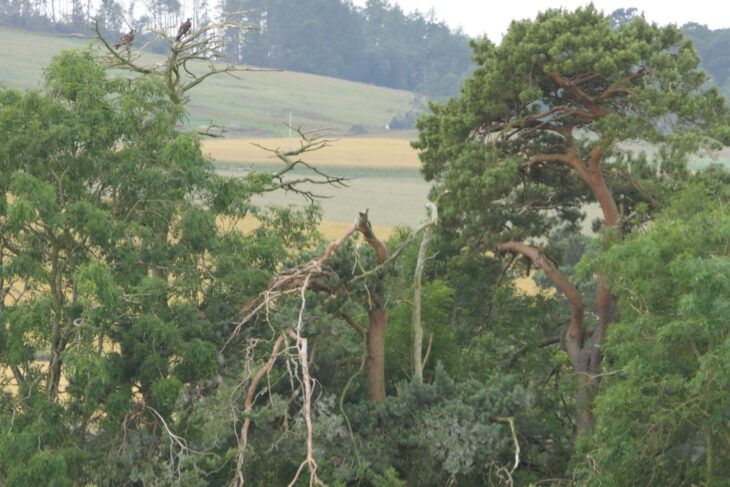
Fortunately for the osprey family’s sole chick, the youngster (who was around 8 week’s old) was close to fledging age and is thought to have part-glided, part-flapped from the fallen tree, only to be found by local regulars Mary and Jim Rogers on the main path that borders the Loch.
Looking like the proverbial ‘fish out of water’ the couple quickly got in touch with the warden Jim Hughes who lives nearby, and swift action was taken to remove the osprey from danger and secure it in a cool shady location.
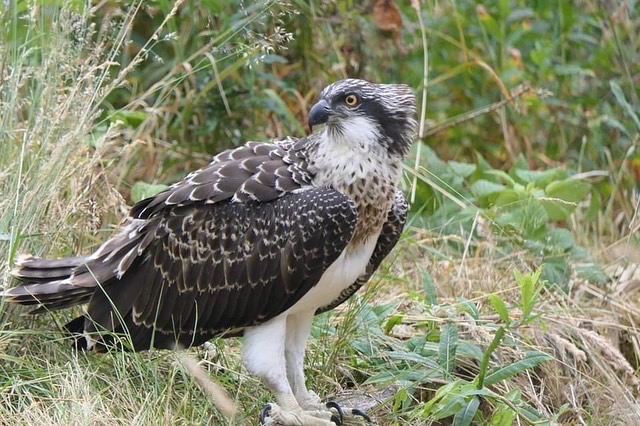
Although it is common to find young fledglings in our own gardens, who will happily spend several days hopping about being fed by their parents before flying for the first time, a young osprey needs height and lift from a breeze to make its maiden flight, and in this case was unlikely to be fed by its parents on the ground.
Whilst the Trust’s policy is to allow nature to take its course, the case for intervening to avoid potentially being attacked by dogs, and with being so close to fledging was clear – we had to find a way to get the young osprey up high again, so that its parents could see it and continue to provision it with food until it was ready to take to the skies.
The priority of course was to first ensure the youngster had not sustained any injuries, particularly to its wings and legs. After being given a clean bill of health the juvenile was treated by Jim to several meals of sea bass no less, which it ate with great enthusiasm.
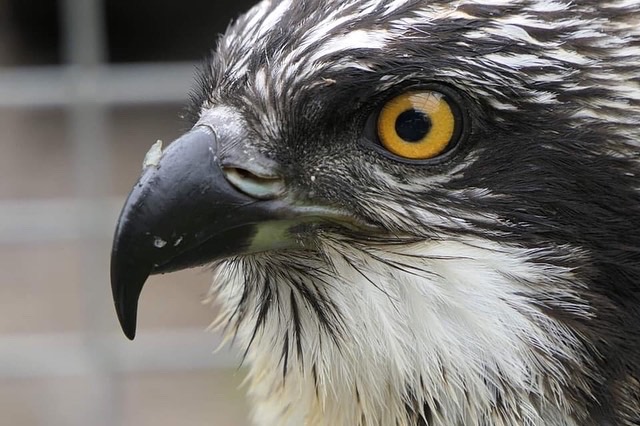
Meanwhile, behind the scenes the next stage of the rescue mission was swinging into action.
Both myself and North East reserves manager Rab Potter spent the day making many phone calls to organise logistics and seeking advice from members of the Tayside and Fife Raptor study group. Offers of specialist help were soon being offered. Trust staff then busied themselves gathering the equipment and the transport required for the rescue mission and were kindly joined by experienced raptor workers James Silvey and Robin Manson later that evening.
James and Robin quickly scoped out the area for a suitable alternative tree that could be used to home a temporary nesting structure – in this case a wire basket, lined with moss and sticks. Past experience suggested that once up high the parents would soon reunite with their offspring and begin feeding it, with the added height providing the youngster with the best chance for a successful fledging when the right time arose.
Despite battling with some angry wasps and receiving multiple stings, James and Robin had soon climbed and prepared the tree for the temporary nest structure. Meanwhile Trust staff, including the Ranger team from Loch of the Lowes, hauled and lugged the canoe into position, made all the more challenging by some territorial swans on the way – thankfully they decided that the Loch was more appealing for an evening swim!
Next was carefully carrying the osprey, secured safely in a cage to the canoe. I have to admit, I have transported many strange things before, but an osprey by canoe is a first! Unlike the swans, the youngster remained calm and relaxed throughout and was soon at the foot of the tree.
Given that both James and Robin are both licensed raptor workers and ringers, it seemed like a good opportunity to have the youngster ringed with the standard BTO metal ring and the larger colour ‘Darvic’ ring. As per all Scottish ospreys the colour ring was placed on its left leg, whereas youngsters from England and Wales are ringed on their right leg. These larger colour rings are often captured at distance by keen photographers with large lenses and are useful for tracking the movements, dispersal and breeding successes of the recovering osprey population throughout the UK, with sightings being collated by the Roy Dennis Foundation.
The osprey was ringed by Robin as ‘Blue 640’, its weight recorded as 2kg and being at the top end of the weight range sexed as likely to be female. Being so close to fledging, it was not possible to take wing measurements due to its sheer size.
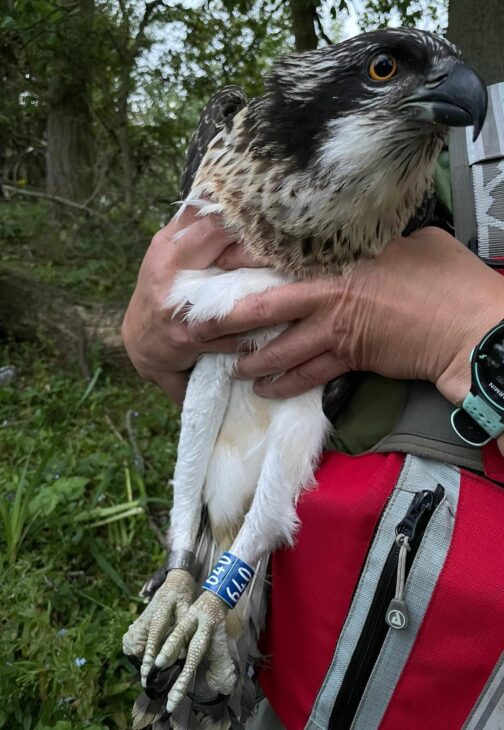
It was a humbling experience to gently, yet securely hold the osprey whilst being ringed, to prevent any untoward flapping. To feel a wild creature’s heart beat and look into its deep orange eyes certainly made me feel alive!
The youngster was soon on its way safely up the tree and as last light fell it was left to settle in its new home for the evening.
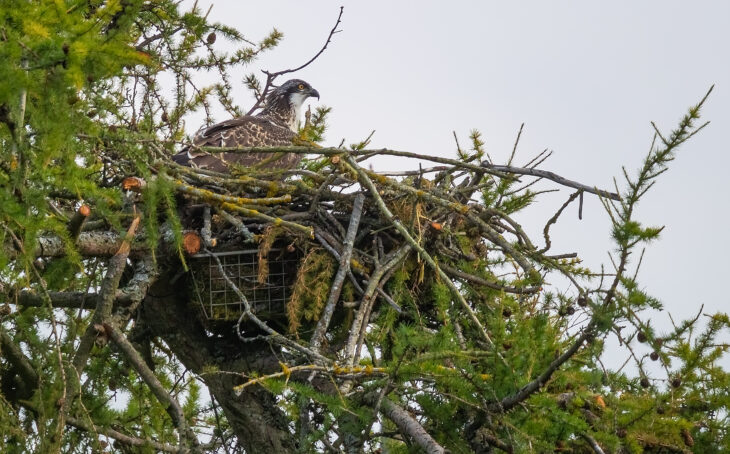
Whilst it was too late at night for the adults to come into the new nest, they were observed flying close by throughout the rescue mission. After carrying all the kit and canoe back to the car park, the team left for the night, exhausted but happy that all had gone well.
You can imagine our delight the next day when we received news from Jim the Warden that the youngster had successfully fledged that morning and was sitting high up in a tree on the island, being fed by its parents – though probably a little miffed that sea bass was not on the menu!

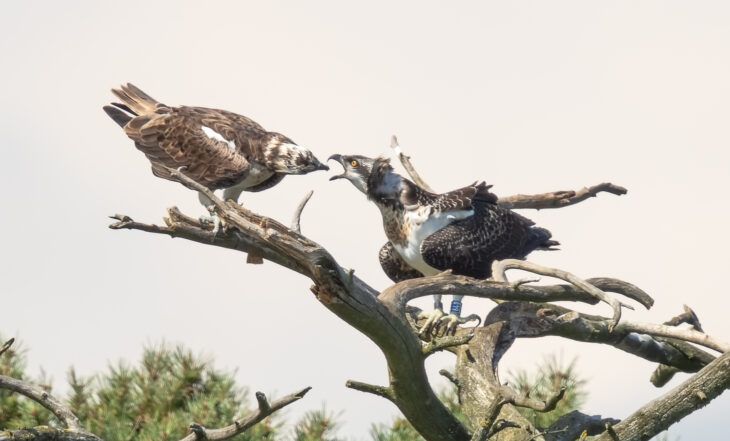
It really was the best of outcomes and truly a team effort; from the quick thinking of Mary and Jim Rogers, the care of Jim the Warden, advice from colleagues in the Tayside and Fife Raptor Study group, support from various Trust staff to move and gather equipment, and crucially the skill, expertise and generous time given by James and Robin to safely put the osprey back up in a new nest – our thanks go to you all!
We look forward to seeing the whole osprey family take to the skies later this month on their annual migration south to sunnier climes.
Raz Rasmussen
‘Perthshire Ranger’
And remember, it’s not too late to see the fledged ospreys at our Loch of the Lowes Wildlife Reserve!
Help protect Scotland’s wildlife
Our work to save Scotland’s wildlife is made possible thanks to the generosity of our members and supporters.
Join today from just £4 a month to help protect the species you love.
Preface
It’s not everyday you receive a phone call to say that the nest of a protected raptor has collapsed, taking a juvenile osprey with it – and yet that is …
